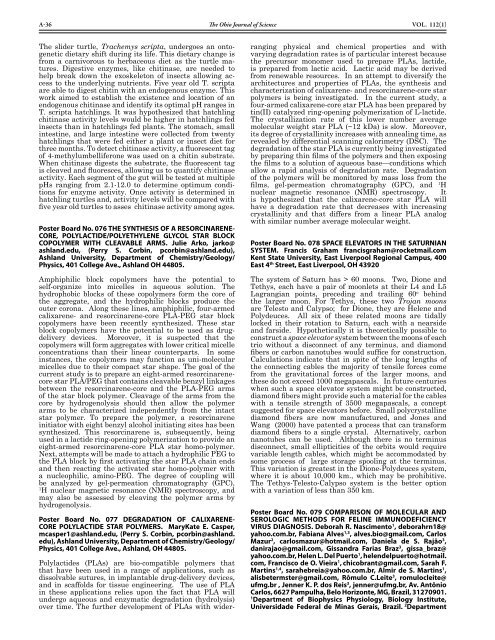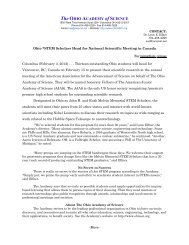The Ohio Journal of - The Ohio Academy of Science
The Ohio Journal of - The Ohio Academy of Science
The Ohio Journal of - The Ohio Academy of Science
You also want an ePaper? Increase the reach of your titles
YUMPU automatically turns print PDFs into web optimized ePapers that Google loves.
A-36 <strong>The</strong> <strong>Ohio</strong> <strong>Journal</strong> <strong>of</strong> <strong>Science</strong><br />
Vol. 112(1)<br />
<strong>The</strong> slider turtle, Trachemys scripta, undergoes an ontogenetic<br />
dietary shift during its life. This dietary change is<br />
from a carnivorous to herbaceous diet as the turtle matures.<br />
Digestive enzymes, like chitinase, are needed to<br />
help break down the exoskeleton <strong>of</strong> insects allowing access<br />
to the underlying nutrients. Five year old T. scripta<br />
are able to digest chitin with an endogenous enzyme. This<br />
work aimed to establish the existence and location <strong>of</strong> an<br />
endogenous chitinase and identify its optimal pH ranges in<br />
T. scripta hatchlings. It was hypothesized that hatchling<br />
chitinase activity levels would be higher in hatchlings fed<br />
insects than in hatchlings fed plants. <strong>The</strong> stomach, small<br />
intestine, and large intestine were collected from twenty<br />
hatchlings that were fed either a plant or insect diet for<br />
three months. To detect chitinase activity, a fluorescent tag<br />
<strong>of</strong> 4-methylumbelliferone was used on a chitin substrate.<br />
When chitinase digests the substrate, the fluorescent tag<br />
is cleaved and fluoresces, allowing us to quantify chitinase<br />
activity. Each segment <strong>of</strong> the gut will be tested at multiple<br />
pHs ranging from 2.1-12.0 to determine optimum conditions<br />
for enzyme activity. Once activity is determined in<br />
hatchling turtles and, activity levels will be compared with<br />
five year old turtles to asses chitinase activity among ages.<br />
Poster Board No. 076 THE SYNTHESIS OF A RESORCINARENE-<br />
CORE, POLYLACTIDE/POLYETHYLENE GLYCOL STAR BLOCK<br />
COPOLYMER WITH CLEAVABLE ARMS. Julie Arko, jarko@<br />
ashland.edu, (Perry S. Corbin, pcorbin@ashland.edu),<br />
Ashland University, Department <strong>of</strong> Chemistry/Geology/<br />
Physics, 401 College Ave., Ashland OH 44805.<br />
Amphiphilic block copolymers have the potential to<br />
self-organize into micelles in aqueous solution. <strong>The</strong><br />
hydrophobic blocks <strong>of</strong> these copolymers form the core <strong>of</strong><br />
the aggregate, and the hydrophilic blocks produce the<br />
outer corona. Along these lines, amphiphilic, four-armed<br />
calixarene- and resorcinarene-core PLA-PEG star block<br />
copolymers have been recently synthesized. <strong>The</strong>se star<br />
block copolymers have the potential to be used as drugdelivery<br />
devices. Moreover, it is suspected that the<br />
copolymers will form aggregates with lower critical micelle<br />
concentrations than their linear counterparts. In some<br />
instances, the copolymers may function as uni-molecular<br />
micelles due to their compact star shape. <strong>The</strong> goal <strong>of</strong> the<br />
current study is to prepare an eight-armed resorcinarenecore<br />
star PLA/PEG that contains cleavable benzyl linkages<br />
between the resorcinarene-core and the PLA-PEG arms<br />
<strong>of</strong> the star block polymer. Cleavage <strong>of</strong> the arms from the<br />
core by hydrogenolysis should then allow the polymer<br />
arms to be characterized independently from the intact<br />
star polymer. To prepare the polymer, a resorcinarene<br />
initiator with eight benzyl alcohol initiating sites has been<br />
synthesized. This resorcinarene is, subsequently, being<br />
used in a lactide ring-opening polymerization to provide an<br />
eight-armed resorcinarene-core PLA star homo-polymer.<br />
Next, attempts will be made to attach a hydrophilic PEG to<br />
the PLA block by first activating the star PLA chain ends<br />
and then reacting the activated star homo-polymer with<br />
a nucleophilic, amino-PEG. <strong>The</strong> degree <strong>of</strong> coupling will<br />
be analyzed by gel-permeation chromatography (GPC),<br />
1 H nuclear magnetic resonance (NMR) spectroscopy, and<br />
may also be assessed by cleaving the polymer arms by<br />
hydrogenolysis.<br />
Poster Board No. 077 DEGRADATION OF CALIXARENE-<br />
CORE POLYLACTIDE STAR POLYMERS. MaryKate E. Casper,<br />
mcasper1@ashland.edu, (Perry S. Corbin, pcorbin@ashland.<br />
edu), Ashland University, Department <strong>of</strong> Chemistry/Geology/<br />
Physics, 401 College Ave., Ashland, OH 44805.<br />
Polylactides (PLAs) are bio-compatible polymers that<br />
that have been used in a range <strong>of</strong> applications, such as<br />
dissolvable sutures, in implantable drug-delivery devices,<br />
and in scaffolds for tissue engineering. <strong>The</strong> use <strong>of</strong> PLA<br />
in these applications relies upon the fact that PLA will<br />
undergo aqueous and enzymatic degradation (hydrolysis)<br />
over time. <strong>The</strong> further development <strong>of</strong> PLAs with wider-<br />
ranging physical and chemical properties and with<br />
varying degradation rates is <strong>of</strong> particular interest because<br />
the precursor monomer used to prepare PLAs, lactide,<br />
is prepared from lactic acid. Lactic acid may be derived<br />
from renewable resources. In an attempt to diversify the<br />
architectures and properties <strong>of</strong> PLAs, the synthesis and<br />
characterization <strong>of</strong> calixarene- and resorcinarene-core star<br />
polymers is being investigated. In the current study, a<br />
four-armed calixarene-core star PLA has been prepared by<br />
tin(II) catalyzed ring-opening polymerization <strong>of</strong> L-lactide.<br />
<strong>The</strong> crystallization rate <strong>of</strong> this lower number average<br />
molecular weight star PLA (~12 kDa) is slow. Moreover,<br />
its degree <strong>of</strong> crystallinity increases with annealing time, as<br />
revealed by differential scanning calorimetry (DSC). <strong>The</strong><br />
degradation <strong>of</strong> the star PLA is currently being investigated<br />
by preparing thin films <strong>of</strong> the polymers and then exposing<br />
the films to a solution <strong>of</strong> aqueous base—conditions which<br />
allow a rapid analysis <strong>of</strong> degradation rate. Degradation<br />
<strong>of</strong> the polymers will be monitored by mass loss from the<br />
films, gel-permeation chromatography (GPC), and 1 H<br />
nuclear magnetic resonance (NMR) spectroscopy. It<br />
is hypothesized that the calixarene-core star PLA will<br />
have a degradation rate that decreases with increasing<br />
crystallinity and that differs from a linear PLA analog<br />
with similar number average molecular weight.<br />
Poster Board No. 078 SPACE ELEVATORS IN THE SATURNIAN<br />
SYSTEM. Francis Graham francisgraham@rocketmail.com<br />
Kent State University, East Liverpool Regional Campus, 400<br />
East 4 th Street, East Liverpool, OH 43920<br />
<strong>The</strong> system <strong>of</strong> Saturn has > 60 moons. Two, Dione and<br />
Tethys, each have a pair <strong>of</strong> moonlets at their L4 and L5<br />
Lagrangian points, preceding and trailing 60 o behind<br />
the larger moon. For Tethys, these two Trojan moons<br />
are Telesto and Calypso; for Dione, they are Helene and<br />
Polydeuces. All six <strong>of</strong> these related moons are tidally<br />
locked in their rotation to Saturn, each with a nearside<br />
and farside. Hypothetically it is theoretically possible to<br />
construct a space elevator system between the moons <strong>of</strong> each<br />
trio without a disconnect <strong>of</strong> any terminus, and diamond<br />
fibers or carbon nanotubes would suffice for construction.<br />
Calculations indicate that in spite <strong>of</strong> the long lengths <strong>of</strong><br />
the connecting cables the majority <strong>of</strong> tensile forces come<br />
from the gravitational forces <strong>of</strong> the larger moons, and<br />
these do not exceed 1000 megapascals. In future centuries<br />
when such a space elevator system might be constructed,<br />
diamond fibers might provide such a material for the cables<br />
with a tensile strength <strong>of</strong> 3500 megapascals, a concept<br />
suggested for space elevators before. Small polycrystalline<br />
diamond fibers are now manufactured, and Jones and<br />
Wang (2000) have patented a process that can transform<br />
diamond fibers to a single crystal. Alternatively, carbon<br />
nanotubes can be used. Although there is no terminus<br />
disconnect, small ellipticities <strong>of</strong> the orbits would require<br />
variable length cables, which might be accommodated by<br />
some process <strong>of</strong> large storage spooling at the terminus.<br />
This variation is greatest in the Dione-Polydeuces system,<br />
where it is about 10,000 km., which may be prohibitive.<br />
<strong>The</strong> Tethys-Telesto-Calypso system is the better option<br />
with a variation <strong>of</strong> less than 350 km.<br />
Poster Board No. 079 COMPARISON OF MOLECULAR AND<br />
SEROLOGIC METHODS FOR FELINE IMMUNODEFICIENCY<br />
VIRUS DIAGNOSIS. Deborah R. Nascimento 1 , deborahrn18@<br />
yahoo.com.br, Fabiana Alves 1,3 , alves.bio@gmail.com, Carlos<br />
Mazur 2 , carlosmazur@hotmail.com, Daniela de S. Rajão 3 ,<br />
danirajao@gmail.com, Gissandra Farias Braz 3 , gissa_braz@<br />
yahoo.com.br, Helen L. Del Puerto 1 , helendelpuerto@hotmail.<br />
com, Francisco de O. Vieira 1 , chicobrant@gmail.com, Sarah F.<br />
Martins 1,4 , sarahebreia@yahoo.com.br, Almir de S. Martins 1 ,<br />
alisbetermster@gmail.com, Rômulo C.Leite 3 , romulocleite@<br />
ufmg.br , Jenner K. P. dos Reis 3 , jenner@ufmg.br, Av. Antônio<br />
Carlos, 6627 Pampulha, Belo Horizonte, MG, Brazil, 31270901.<br />
1 Department <strong>of</strong> Biophysics Physiology, Biology Institute,<br />
Universidade Federal de Minas Gerais, Brazil. 2 Department












